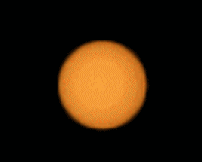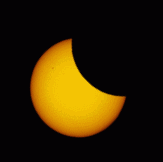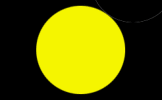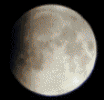Coordinated Universal Time (UTC)
Solar and Lunar eclipses
Solar eclipse
- astronomical phenomenon when for an observer on earth the moon partially or
completely obscure the sun. The solar eclipse is only possible in
New moon![]() , and only if the new moon occurs near one of the two
Lunar node
, and only if the new moon occurs near one of the two
Lunar node![]() - the point of
intersection of the orbit of the moon with
Ecliptic
- the point of
intersection of the orbit of the moon with
Ecliptic![]() . The shadow of the moon on the
earth's surface does not exceed a diameter of 270 km , so the eclipse is
observed only in a narrow band in the shadow of the way. As the moon revolves
around the Earth in an elliptical orbit, the distance between the Earth and the
Moon at the time of the eclipse may be different and therefore the Moon's shadow
spot diameter on the surface of the Earth varies widely from maximum to zero -
in this case, the Moon's shadow vertex of the cone reaches the Earth's surface
visually Moon passes across the solar disk, but is less than the Sun's diameter.
The maximum phase of the eclipse of the sun the moon rose, but around the moon
can be seen a bright ring uncovered part of the solar disk - it
Annular Solar Eclipse.
Sky with annular eclipse
remains bright, the stars did not appear, watch the solar corona is not
possible. The same parts in different eclipse eclipse bands can be seen as a
full or annular. This eclipse is called a hybrid. Eclipse, in which the visible
disk of the Moon covers the visible disk of the Sun is not completely called
private
,
ie, Partial eclipse.
. The shadow of the moon on the
earth's surface does not exceed a diameter of 270 km , so the eclipse is
observed only in a narrow band in the shadow of the way. As the moon revolves
around the Earth in an elliptical orbit, the distance between the Earth and the
Moon at the time of the eclipse may be different and therefore the Moon's shadow
spot diameter on the surface of the Earth varies widely from maximum to zero -
in this case, the Moon's shadow vertex of the cone reaches the Earth's surface
visually Moon passes across the solar disk, but is less than the Sun's diameter.
The maximum phase of the eclipse of the sun the moon rose, but around the moon
can be seen a bright ring uncovered part of the solar disk - it
Annular Solar Eclipse.
Sky with annular eclipse
remains bright, the stars did not appear, watch the solar corona is not
possible. The same parts in different eclipse eclipse bands can be seen as a
full or annular. This eclipse is called a hybrid. Eclipse, in which the visible
disk of the Moon covers the visible disk of the Sun is not completely called
private
,
ie, Partial eclipse.
![]() Partial Solar Eclipse in Riga
Partial Solar Eclipse in Riga
Lunar eclipse
- astronomical phenomenon when the moon enters the shadow cone cast by the Earth
into space. The diameter of the Earth's shadow spot at a distance of
363,000 km (the minimum distance of the Moon from the Earth) is
about 2.6 diameters of the moon , so the moon
can be fully shaded. When the moon during an eclipse fully enters the Earth's
shadow in a total lunar eclipse occurs when the part - it is a partial eclipse.
Two necessary and sufficient conditions for the onset of a lunar eclipse is
Full moon![]() and the proximity of the
Earth to the lunar node. If the Moon enters the full shadow of the Earth is only
partially observed a partial eclipse - part of the moon is dark, and some even
in the maximum phase, remains in partial shade and illuminated by sunlight. If
the Moon passes the penumbra region, but is not included into the shadows, there
is a penumbral eclipse: Moon brightness decreases slightly.
and the proximity of the
Earth to the lunar node. If the Moon enters the full shadow of the Earth is only
partially observed a partial eclipse - part of the moon is dark, and some even
in the maximum phase, remains in partial shade and illuminated by sunlight. If
the Moon passes the penumbra region, but is not included into the shadows, there
is a penumbral eclipse: Moon brightness decreases slightly.
Solar Eclipses: Past and Future
![]()
Lunar Eclipses: Past and Future
![]()



